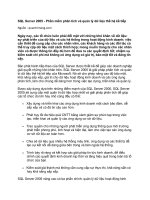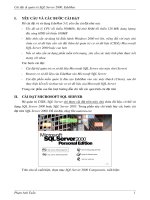Bài giảng Client/Server - Chương 7: Quản trị SQL Server 2005 (Phần 2) docx
Bạn đang xem bản rút gọn của tài liệu. Xem và tải ngay bản đầy đủ của tài liệu tại đây (260.09 KB, 9 trang )
1
Bài 7: Quản trị MS SQL Server 2005
SQL Server Surface Area Configuration
•
On the Start menu, point to All Programs, Microsoft SQL Server 2005,
Configuration Tools, and then click SQL Server Surface Area Configuration.
2
Cấu hình các dịch vụ
•
Chọn mục: Surface Area Configuration for Services and Connections.
3
Cấu hình: Database Engine, Analysis Services, and Reporting Services
•
Chọn mục: Surface Area Configuration for Features.
4
Cấu hình Protocol, Port
5
xp_cmdshell
•
Cú pháp:
–
xp_cmdshell { 'command_string' } [ , no_output ]
Ví dụ:
EXEC master xp_cmdshell 'dir *.exe'
DECLARE @result int
EXEC @result = xp_cmdshell 'dir *.exe'
IF (@result = 0)
PRINT 'Success'
ELSE
PRINT 'Failure'
6
xp_cmdshell
•
exec master.dbo.xp_cmdshell 'mkdir "d:\new_job\"'
•
go
•
exec master.dbo.xp_cmdshell 'copy c:\*.txt D:\new_job‘
•
Go
•
EXEC xp_cmdshell 'tree D:\'
7
Writing variable contents to a table (xp_cmd.sql)
SET NOCOUNT ON
1 - Variable declarations
DECLARE @CMD1 varchar(5000)
DECLARE @CMD2 varchar(5000)
DECLARE @FilePath varchar(200)
2 - Create the #OriginalFileList temporary table to support the un-cleansed
file list
CREATE TABLE #OriginalFileList (
Col1 varchar(1000) NULL
)
3 - Create the #ParsedFileList temporary table to suppor the cleansed file list
CREATE TABLE #ParsedFileList (
PFLID INT PRIMARY KEY IDENTITY (1,1) NOT NULL,
DateTimeStamp datetime NOT NULL,
FileSize varchar(50) NOT NULL,
FileName1 varchar (255) NOT NULL)
8
Writing variable contents to a table
4 - Initialize the variables
SELECT @CMD1 = ''
SELECT @CMD2 = ''
SELECT @FilePath = 'D:\new_job\'
5 - Build the string to capture the file names in the restore location
SELECT @CMD1 = 'master.dbo.xp_cmdshell ' + char(39) + 'dir ' +
@FilePath + '\*.*' + char(39)
6 - Build the string to populate the #OriginalFileList temporary table
SELECT @CMD2 = 'INSERT INTO #OriginalFileList(Col1)' + char(13) +
'EXEC ' + @CMD1
7 - Execute the string to populate the #OriginalFileList table
EXEC (@CMD2)
8 - Delete unneeded data from the #OriginalFileList
DELETE FROM #OriginalFileList
WHERE Col1 IS NULL
9
Writing variable contents to a table
DELETE FROM #OriginalFileList WHERE Col1 LIKE '%Volume%'
DELETE FROM #OriginalFileList WHERE Col1 LIKE '%Directory%'
DELETE FROM #OriginalFileList WHERE Col1 LIKE '%<DIR>%'
DELETE FROM #OriginalFileList WHERE Col1 LIKE '%bytes%'
9 - Populate the #ParsedFileList table with the final data
select * from #OriginalFileList
INSERT INTO #ParsedFileList (DateTimeStamp, FileSize, FileName1)
SELECT LTRIM(SUBSTRING (Col1, 1, 20)) AS 'DateTimeStamp',
LTRIM(SUBSTRING (Col1, 21, 18)) AS 'FileSize',
LTRIM(SUBSTRING (Col1, 40, 1000)) AS 'FileName1'
FROM #OriginalFileList
INSERT code here to process the data from the #ParsedFileList table
10 - Drop the temporary tables
DROP TABLE #OriginalFileList
DROP TABLE #ParsedFileList
SET NOCOUNT OFF









